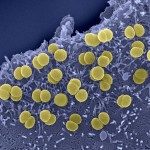Lien vers Pubmed [PMID] – 32827751
Lien DOI – S1201-9712(20)30669-X10.1016/j.ijid.2020.08.040
Int J Infect Dis 2020 Aug; 100(): 12-20
To identifyHaemophilus species and characterise the antimicrobial susceptibility of isolates from patients with respiratory tract infections (RTIs) in Cameroon.Isolates (n = 95) were from patients with RTIs obtained from two hospitals in Yaoundé, Cameroon. Isolates were identified by biochemical assay, a polymerase chain reaction (PCR)-based method, matrix-assisted laser desorption ionization-time of flight (MALDI-TOF), and whole genome sequencing. Antibiotic minimum inhibitory concentrations were determined by E-test.Haemophilus influenzae (H. influenzae) was the most prevalent species, varying from 76.8 to 84.2% according to the different methods. The isolates were mainly non-typeable (n = 70, 96%). Three H. influenzae isolates were capsulated (b, e and f). The isolates were genetically diverse and 40 unique sequence types were identified, including 11 new ones. Resistance to ampicillin was observed among 52 of 94 (55.3%), and 14 of the 52 (26.9%) produced TEM-1 β-lactamase. PBP3 mutations occurred in 40 of 52 (76.9%) ampicillin-resistant isolates. Eleven isolates were chloramphenicol-resistant, with eight of 10 (80%) producing chloramphenicol acetyltransferase. Four Haemophilus isolates were rifampicin-resistant, with two mutations in rpoB gene. Five isolates were ciprofloxacin-resistant and harboured mutations in the quinolone-resistance-determining regions of gyrA and parC genes.TheH. influenzae isolates were highly diverse and showed high levels of antibiotic resistance. H. influenzae serotype b is still circulating in the post-vaccination era.

